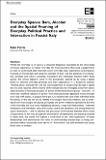Files in this item
Everyday spaces : bars, alcohol and the spatial framing of everyday political practice and interaction in fascist Italy
Item metadata
| dc.contributor.author | Ferris, Kate | |
| dc.date.accessioned | 2022-04-13T12:30:05Z | |
| dc.date.available | 2022-04-13T12:30:05Z | |
| dc.date.issued | 2022-04-01 | |
| dc.identifier | 277772470 | |
| dc.identifier | 6c8c1dff-9c1b-4bfb-9ca5-71e54b8b50c9 | |
| dc.identifier | 000776169900002 | |
| dc.identifier | 85128243048 | |
| dc.identifier.citation | Ferris , K 2022 , ' Everyday spaces : bars, alcohol and the spatial framing of everyday political practice and interaction in fascist Italy ' , European History Quarterly , vol. 52 , no. 2 , pp. 136-159 . https://doi.org/10.1177/02656914221085131 | en |
| dc.identifier.issn | 0265-6914 | |
| dc.identifier.other | ORCID: /0000-0002-3707-5618/work/111547264 | |
| dc.identifier.uri | https://hdl.handle.net/10023/25181 | |
| dc.description | Funding: This work was supported by the Arts and Humanities Research Council [grant number: AH/L007436/1]. | en |
| dc.description.abstract | Whilst the ‘everyday’ is, of course, a temporal designator, connected to the chronology of human experience, in reality, ‘everyday life’ historians have often used a spatial frame to seek to understand past historical actors’ everyday lives, experiences and practices. Focusing on Fascist Italy and using the example of ‘bars’ and the practices of consumption, political (and other) sociability, transaction and exchanges enacted within these spaces, this article explores some of the possibilities opened up by using a spatial frame to examine everyday practices and lived experiences in a dictatorial context. Thinking about ‘everyday life’ and the lived experience of dictatorship through a spatial lens not only requires a shift in terms of the venues that we investigate, away from classic seats and sites of formal projections of power and towards those spaces – like bars – in which the ‘unofficial relations of power’ were articulated and negotiated. It also prompts us to ‘play with scales’, as Jacques Revel put it, to examine the unit of the individual body, the street, or the city not just to identify microscopic historical practices, but to understand how macroscopic structures, processes and power relations operated at the level of the everyday and vice versa, highlighting dynamic, reciprocal relationships – between institutions and individuals, state and society, centre and periphery, and among historical actors themselves – and to examine the processes of movement between these scales of experience. In this way, through the examination of interactions and practices enacted in Italian bars, the article will explore a novel facet of the ‘lived experience’ of these dictatorships and demonstrate the value in understanding dictatorships as being constructed neither exclusively ‘from above’ or ‘from below’ but both between and across these units of analysis. | |
| dc.format.extent | 517664 | |
| dc.language.iso | eng | |
| dc.relation.ispartof | European History Quarterly | en |
| dc.subject | Alcohol consumption | en |
| dc.subject | Bars | en |
| dc.subject | Everyday life | en |
| dc.subject | Fascism | en |
| dc.subject | Italy | en |
| dc.subject | Space | en |
| dc.subject | DG Italy | en |
| dc.subject | HN Social history and conditions. Social problems. Social reform | en |
| dc.subject | 3rd-DAS | en |
| dc.subject.lcc | DG | en |
| dc.subject.lcc | HN | en |
| dc.title | Everyday spaces : bars, alcohol and the spatial framing of everyday political practice and interaction in fascist Italy | en |
| dc.type | Journal article | en |
| dc.contributor.sponsor | European Research Council | en |
| dc.contributor.sponsor | Arts and Humanities Research Council | en |
| dc.contributor.institution | University of St Andrews. St Andrews Institute for Transnational & Spatial History | en |
| dc.contributor.institution | University of St Andrews. School of History | en |
| dc.identifier.doi | 10.1177/02656914221085131 | |
| dc.description.status | Peer reviewed | en |
| dc.date.embargoedUntil | 2022-03-30 | |
| dc.identifier.url | https://journals.sagepub.com/toc/ehqb/52/2 | en |
| dc.identifier.grantnumber | 772353 | en |
| dc.identifier.grantnumber | AH/L007436/1 | en |
This item appears in the following Collection(s)
Items in the St Andrews Research Repository are protected by copyright, with all rights reserved, unless otherwise indicated.

